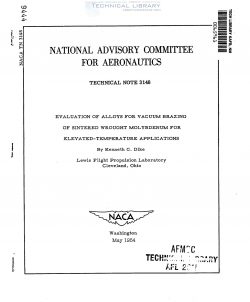naca-tn-3148
- Version
- 45 Downloads
- 574.03 KB File Size
- 1 File Count
- January 23, 2017 Create Date
- January 23, 2017 Last Updated
National Advisory Committee for Aeronautics, Technical Notes - Evaluation of Alloys for Vacuum Brazing of Sintered Wrought Molybdenum for Elevated Temperature Applications

In a search for potential brazing alloys for molybdenum for use at
elevated temperatures, 25 binary and ternary alloys, with liquidus tem—
peratures in the range 20000 to 25000 F, were prepared and evaluated.
Three commercial alloys were also evaluated. The brazing characteris-
tics were established in vacuum.
The room-temperature tensile strengths of buttAbrazed molybdenum
joints of the 15 alloys having the most promising brazing characteris-
tics ranged from 8450 to 49,400 pounds per square inch. The 10 alloys
which possessed roomrtemperature strengths higher than 21,000 pounds
per square inch were tested at 18000 F. At this temperature, strengths
varied from O to 18,900 pounds per square inch.
The three alloys which had 1.8000 F bonding strengths of 17,000 to
19,000 pounds per square inch were considered satisfactory and were
heated at 18000 F in vacuum for 24 hours to determine the extent of
diffusion and the effect on tensile strength. The 84 percent nickel —
16 percent titanium and the 52 percent niobium - 48 percent nickel alloy
bonds seemed unaffected by a time of 24 hours at temperature; there-
fore, these two binary alloys may be potentially useful brazing alloys
for molybdenum for elevated-temperature applications. The time at
temperature, however, was detrimental to the 50 percent iron - 50 per-
cent palladium_alloy since the 18000 F strength dropped from 17,000 to
7000 pounds per square inch.
The many research data published in the last several years on the
properties of molybdenum definitely show that this high-melting-point
metal has an excellent potentiality for high-temperature applications
in the range of 18.000 to 20000 F. Molybdenum, however, has two very
undesirable characteristics, namely, poor oxidation resistance above
10000 F and difficult Joining properties.
Considerable data exist in the literature_on the joining of
molybdenum by several welding methods. In general, most welds made
were unsatisfactory because of porosity, cracks, or impurities in the
weld and particularly because of recrystallization in the heat-affected
zone, all of which can contribute to the embrittlement of the metal.
Occasionally, ductile recrystallized welds can be made, but these have
not been duplicated consistently.
| File | Action |
|---|---|
| naca-tn-3148 Evaluation of Alloys for Vacuum Brazing of Sintered Wrought Molybdenum for Elevated Temperature Applications.pdf | Download |

Comment On This Post